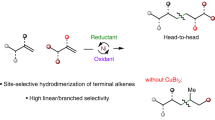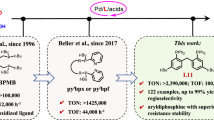Abstract
A new nickel diphosphine catalyst has been synthesized in which the bidentate ligand has two different phosphine donors, a typical PPh2 group and a stronger σ-donating PEt2 group. The catalyst was highly effective for the chain-growth polymerization of a 3-alkylthiophene monomer using a Suzuki–Miyaura cross-coupling. The catalyst is particularly effective for this polymerization in the presence of excess free ligand. The unsymmetrical diphosphine nickel complex reported here represents a new approach to tuning metal-ligand reactivity in the chain-growth polymerization of aromatic monomers. In addition, this new nickel catalyst exhibited increased hydrolytic resistance in the polymerization as compared to commercially available 1,3-bis(diphenylphosphino)propane nickel dichloride.
This is a preview of subscription content, access via your institution
Access options
Subscribe to this journal
Receive 12 print issues and online access
$259.00 per year
only $21.58 per issue
Buy this article
- Purchase on Springer Link
- Instant access to full article PDF
Prices may be subject to local taxes which are calculated during checkout










Similar content being viewed by others
References
He WY, Patrick BO, Kennepohl P. Identifying the missing link in catalyst transfer polymerization. Nat Commun. 2018;9:3866.
Leone AK, Goldberg PK, McNeil AJ. Ring-walking in catalyst-transfer polymerization. J Am Chem Soc. 2018;140:7846–50.
Baker MA, Tsai CH, Noonan KJT. Diversifying cross-coupling strategies, catalysts and monomers for the controlled synthesis of conjugated polymers. Chem Eur J. 2018;24:13078–88.
Verheyen L, Leysen P, Van den Eede M-P, Ceunen W, Hardeman T, Koeckelberghs G. Advances in the controlled polymerization of conjugated polymers. Polymer. 2017;108:521–46.
Yokozawa T, Ohta Y. Transformation of step-growth polymerization into living chain-growth polymerization. Chem Rev. 2016;116:1950–68.
Leone AK, McNeil AJ. Matchmaking in catalyst-transfer polycondensation: optimizing catalysts based on mechanistic insight. Acc Chem Res. 2016;49:2822–31.
Bryan ZJ, McNeil AJ. Conjugated polymer synthesis via catalyst-transfer polycondensation (CTP): mechanism, scope, and applications. Macromolecules. 2013;46:8395–405.
Okamoto K, Luscombe CK. Controlled polymerizations for the synthesis of semiconducting conjugated polymers. Polym Chem. 2011;2:2424–34.
Yokozawa T, Yokoyama A. Chain-growth condensation polymerization for the synthesis of well-defined condensation polymers and π-conjugated polymers. Chem Rev. 2009;109:5595–619.
Grisorio R, Suranna GP. Intramolecular catalyst transfer polymerisation of conjugated monomers: from lessons learned to future challenges. Polym Chem. 2015;6:7781–95.
Leone AK, Mueller EA, McNeil AJ. The history of palladium-catalyzed cross-couplings should inspire the future of catalyst-transfer polymerization. J Am Chem Soc. 2018;140:15126–39.
Sugita H, Nojima M, Ohta Y, Yokozawa T. Unstoichiometric Suzuki–Miyaura cyclic polymerization of extensively conjugated monomers. Polym Chem. 2019;10:1182–5.
Kosaka K, Uchida T, Mikami K, Ohta Y, Yokozawa T. AmPhos Pd-catalyzed Suzuki Miyaura catalyst-transfer condensation polymerization: narrower dispersity by mixing the catalyst and base prior to polymerization. Macromolecules. 2018;51:364–9.
Seo K-B, Lee I-H, Lee J, Choi I, Choi T-L. A rational design of highly controlled Suzuki–Miyaura catalyst-transfer polycondensation for precision synthesis of polythiophenes and their block copolymers: marriage of palladacycle precatalysts with MIDA-boronates. J Am Chem Soc. 2018;140:4335–43.
Sugita H, Nojima M, Ohta Y, Yokozawa T. Unusual cyclic polymerization through Suzuki–Miyaura coupling of polyphenylene bearing diboronate at both ends with excess dibromophenylene. Chem Commun. 2017;53:396–9.
Grisorio R, Suranna GP. Impact of precatalyst activation on Suzuki-Miyaura catalyst-transfer polymerizations: new mechanistic scenarios for pre-transmetalation events. ACS Macro Lett. 2017;6:1251–6.
Zhang H-H, Peng W, Dong J, Hu Q-S. t-Bu3P-coordinated 2-Phenylaniline-based palladacycle complex/ArBr as robust initiators for controlled Pd(0)/t-Bu3P-catalyzed Suzuki cross-coupling polymerization of AB-type monomers. ACS Macro Lett. 2016;5:656–60.
Zhang H-H, Xing C-H, Hu Q-S, Hong K. Controlled Pd(0)/t-Bu3P-catalyzed Suzuki cross-coupling polymerization of AB-type monomers with ArPd(t-Bu3P)X or Pd2(dba)3/t-Bu3P/ArX as the initiator. Macromolecules. 2015;48:967–78.
Kosaka K, Ohta Y, Yokozawa T. Influence of the boron moiety and water on Suzuki-Miyaura catalyst-transfer condensation polymerization. Macromol Rapid Commun. 2015;36:373–7.
Sui A, Shi X, Tian H, Geng Y, Wang F. Suzuki-Miyaura catalyst-transfer polycondensation with Pd(IPr)(OAc)2 as the catalyst for the controlled synthesis of polyfluorenes and polythiophenes. Polym Chem. 2014;5:7072–80.
Grisorio R, Mastrorilli P, Suranna GP. A Pd(AcO)2/t-Bu3P/K3PO4 catalytic system for the control of Suzuki cross-coupling polymerisation. Polym Chem. 2014;5:4304–10.
Zhang H-H, Xing C-H, Hu Q-S. Controlled Pd(0)/t-Bu3P-catalyzed Suzuki cross-coupling polymerization of AB-type monomers with PhPd(t-Bu3P)I or Pd2(dba)3/t-Bu3P/ArI as the initiator. J Am Chem Soc. 2012;134:13156–9.
Yokozawa T, Suzuki R, Nojima M, Ohta Y, Yokoyama A. Precision synthesis of poly(3-hexylthiophene) from catalyst-transfer Suzuki−Miyaura coupling polymerization. Macromol Rapid Commun. 2011;32:801–6.
Yokoyama A, Suzuki H, Kubota Y, Ohuchi K, Higashimura H, Yokozawa T. Chain-growth polymerization for the synthesis of polyfluorene via Suzuki−Miyaura coupling reaction from an externally added initiator unit. J Am Chem Soc. 2007;129:7236–7.
Baker MA, Zahn SF, Varni AJ, Tsai CH, Noonan KJT. Elucidating the role of diphosphine ligand in nickel-mediated Suzuki-Miyaura polycondensation. Macromolecules. 2018;51:5911–7.
Qiu Y, Worch JC, Fortney A, Gayathri C, Gil RR, Noonan KJT. Nickel-catalyzed Suzuki polycondensation for controlled synthesis of ester-functionalized conjugated polymers. Macromolecules. 2016;49:4757–62.
Benn FR, Briggs JC, McAuliffe CA. Unsymmetrical bis(phosphorus) compounds: synthesis of unsymmetrical ditertiary phosphines, phosphine oxides, and diquaternary phosphonium salts. J Chem Soc Dalton Trans. 1984:293–5.
Briggs JC, McAuliffe CA, Hill WE, Minahan DMA, Dyer G. Unsymmetrical bisphosphorus ligands - Phosphorus-31 and Carbon-13 nuclear magnetic-resonance and mass-spectral measurements. J Chem Soc Perkin Trans 2. 1982:321–5.
Briggs JC, Dyer G. New synthesis of unsymmetrical bidendate phosphine ligands. Chem Ind. 1982:163–4.
Petit C, Favre-Reguillon A, Albela B, Bonneviot L, Mignani G, Lemaire M. Mechanistic Insight into the reduction of tertiary phosphine oxides by Ti(OiPr)4/TMDS. Organometallics. 2009;28:6379–82.
Liversedge IA, Higgins SJ, Giles M, Heeney M, McCulloch I. Suzuki route to regioregular polyalkylthiophenes using Ir-catalysed borylation to make the monomer, and Pd complexes of bulky phosphanes as coupling catalysts for polymerisation. Tetrahedron Lett. 2006;47:5143–6.
Harris RK, Becker ED, De Menezes SMC, Goodfellow R, Granger P. NMR nomenclature. Nuclear spin properties and conventions for chemical shifts (IUPAC recommendations 2001). Pure Appl Chem. 2001;73:1795–818.
CrysAlisPro; The Woodlands, TX: Rigaku OD; 2015.
Sheldrick G. SHELXT—integrated space-group and crystal-structure determination. Acta Cryst Sec A. 2015;71:3–8.
Sheldrick G. A short history of SHELX. Acta Cryst Sec A. 2008;64:112–22.
Müller P. Practical suggestions for better crystal structures. Crystallogr Rev. 2009;15:57–83.
Kohn P, Huettner S, Komber H, Senkovskyy V, Tkachov R, Kiriy A, et al. On the role of single regiodefects and polydispersity in regioregular poly(3-hexylthiophene): defect distribution, synthesis of defect-free chains, and a simple model for the determination of crystallinity. J Am Chem Soc. 2012;134:4790–805.
Bronstein HA, Luscombe CK. Externally initiated regioregular P3HT with controlled molecular weight and narrow polydispersity. J Am Chem Soc. 2009;131:12894–5.
Iovu MC, Sheina EE, Gil RR, McCullough RD. Experimental evidence for the quasi-“living” nature of the Grignard metathesis method for the synthesis of regioregular poly(3-alkylthiophenes). Macromolecules. 2005;38:8649–56.
Frisch MJ, Trucks GW, Schlegel HB, Scuseria GE, Robb MA, Cheeseman JR, et al. Gaussian 09. Gaussian, Inc., Wallingford, CT: Gaussian, Inc.; 2009.
Pople JA. The effect of quadrupole relaxation on nuclear magnetic resonance multiplets. Mol Phys. 1958;1:168–74.
Bomfim JAS, de Souza FP, Filgueiras CAL, de Sousa AG, Gambardella MTP. Diphosphine complexes of nickel: analogies in molecular structures and variety in crystalline arrangement. Polyhedron. 2003;22:1567–73.
Thomas AA, Zahrt AF, Delaney CP, Denmark SE. Elucidating the role of the boronic esters in the Suzuki–Miyaura reaction: structural, kinetic, and computational investigations. J Am Chem Soc. 2018;140:4401–16.
Thomas AA, Denmark SE. Pre-transmetalation intermediates in the Suzuki-Miyaura reaction revealed: the missing link. Science. 2016;352:329–32.
Lennox AJJ, Lloyd-Jones GC. Transmetalation in the Suzuki–Miyaura coupling: the fork in the trail. Angew Chem Int Ed. 2013;52:7362–70.
Carrow BP, Hartwig JF. Distinguishing between pathways for transmetalation in Suzuki-Miyaura reactions. J Am Chem Soc. 2011;133:2116–9.
Amatore C, Jutand A, Le Duc G. Kinetic data for the transmetalation/reductive elimination in palladium-catalyzed Suzuki-Miyaura reactions: unexpected triple role of hydroxide ions used as base. Chem Eur J. 2011;17:2492–503.
Schmidt AF, Kurokhtina AA, Larina EV. Role of a base in Suzuki-Miyaura reaction. Russ J Gen Chem. 2011;81:1573.
Christian AH, Muller P, Monfette S. Nickel hydroxo complexes as intermediates in nickel-catalyzed Suzuki-Miyaura cross-coupling. Organometallics. 2014;33:2134–7.
Inada K, Miyaura N. Synthesis of biaryls via cross-coupling reaction of arylboronic acids with aryl chlorides catalyzed by NiCl2/triphenylphosphine complexes. Tetrahedron. 2000;56:8657–60.
Ueda M, Saitoh A, Oh-tani S, Miyaura N. Synthesis of biaryls via nickel-catalyzed cross-coupling reaction of arylboronic acids and aryl mesylates. Tetrahedron. 1998;54:13079–86.
Saito S, Oh-tani S, Miyaura N. Synthesis of biaryls via a nickel(0)-catalyzed cross-coupling reaction of chloroarenes with arylboronic acids. J Org Chem. 1997;62:8024–30.
Lanni EL, McNeil AJ. Evidence for ligand-dependent mechanistic changes in nickel-catalyzed chain-growth polymerizations. Macromolecules. 2010;43:8039–44.
Senkovskyy V, Sommer M, Tkachov R, Komber H, Huck WTS, Kiriy A. Convenient route to initiate Kumada catalyst-transfer polycondensation using Ni(dppe)Cl2 or Ni(dppp)Cl2 and sterically hindered Grignard compounds. Macromolecules. 2010;43:10157–61.
Senkovskyy V, Tkachov R, Beryozkina T, Komber H, Oertel U, Horecha M, et al. “Hairy” poly(3-hexylthiophene) particles prepared via surface-initiated Kumada catalyst-transfer polycondensation. J Am Chem Soc. 2009;131:16445–53.
Boyd SD, Jen AK-Y, Luscombe CK. Steric stabilization effects in nickel-catalyzed regioregular poly(3-hexylthiophene) synthesis. Macromolecules. 2009;42:9387–9.
Doubina N, Ho A, Jen AK-Y, Luscombe CK. Effect of initiators on the Kumada catalyst-transfer polycondensation reaction. Macromolecules. 2009;42:7670–7.
Sheina EE, Liu J, Iovu MC, Laird DW, McCullough RD. Chain growth mechanism for regioregular nickel-initiated cross-coupling polymerizations. Macromolecules. 2004;37:3526–8.
Saito S, Sakai M, Miyaura N. A synthesis of biaryls via nickel(0)-catalyzed cross-coupling reaction of chloroarenes with phenylboronic acids. Tetrahedron Lett. 1996;37:2993–6.
Zenkina O, Altman M, Leitus G, Shimon LJW, Cohen R, van der Boom ME. From azobenzene coordination to aryl-halide bond activation by platinum. Organometallics. 2007;26:4528–34.
Yokoyama A, Kato A, Miyakoshi R, Yokozawa T. Precision synthesis of poly (N-hexylpyrrole) and its diblock copolymer with poly(p-phenylene) via catalyst-transfer polycondensation. Macromolecules. 2008;41:7271–3.
Hall AO, Lee SR, Bootsma AN, Bloom JWG, Wheeler SE, McNeil AJ. Reactive ligand influence on initiation in phenylene catalyst-transfer polymerization. J Polym Sci Part A Polym Chem. 2017;55:1530–5.
Lee JA, Luscombe CK. Dual-catalytic Ag-Pd system for direct arylation polymerization to synthesize poly(3-hexylthiophene). ACS Macro Lett. 2018;7:767–71.
Acknowledgements
K.J.T.N. is grateful to the NSF for a CAREER Award (CHE-1455136). The NMR instrumentation at Carnegie Mellon University is partially supported by the NSF (CHE-0130903, CHE-1039870, and CHE-1726525). The authors would also like to thank both Prof. Tsutomu Yokozawa and Prof. Anne McNeil for helpful discussions.
Author information
Authors and Affiliations
Corresponding author
Ethics declarations
Conflict of interest
The authors declare that they have no conflict of interest.
Additional information
Publisher’s note: Springer Nature remains neutral with regard to jurisdictional claims in published maps and institutional affiliations.
Supplementary information
Rights and permissions
About this article
Cite this article
Baker, M.A., Ayuso-Carrillo, J., Koos, M.R.M. et al. A robust nickel catalyst with an unsymmetrical propyl-bridged diphosphine ligand for catalyst-transfer polymerization. Polym J 52, 83–92 (2020). https://doi.org/10.1038/s41428-019-0259-3
Received:
Revised:
Accepted:
Published:
Issue Date:
DOI: https://doi.org/10.1038/s41428-019-0259-3
This article is cited by
-
An isolable, chelating bis[cyclic (alkyl)(amino)carbene] stabilizes a strongly bent, dicoordinate Ni(0) complex
Nature Communications (2024)



